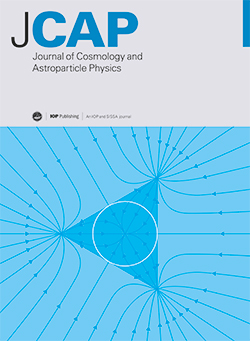初始条件对拟正态模态的影响
IF 5.9
2区 物理与天体物理
Q1 ASTRONOMY & ASTROPHYSICS
Journal of Cosmology and Astroparticle Physics
Pub Date : 2025-07-27
DOI:10.1088/1475-7516/2025/07/084
引用次数: 0
摘要
本文研究了初始条件对线性拟正态模态演化和性质的影响。使用一个具有delta有效势的玩具模型,其中准正态模可以明确识别,我们强调了QNM的一个长期已知但经常被忽视的方面:QNM的振幅(在分解出具有复频率的相应指数之后)不是恒定的,而是随时间变化的。我们强调,即使在线性摄动理论的有效性范围内,这也是正确的。精确的时间变化取决于初始条件,正如我们在这里展示的高斯和s形初始条件。此外,有可能找到QNM甚至无法实现的初始条件;也有可能找到QNM振幅无限增长的那些。关注QNM振幅在后期稳定的情况,我们探讨了振幅稳定的时间尺度如何取决于初始扰动剖面的形状和位置。我们的研究结果强调了在拟合线性QNMs以ringdown数据以及更好地理解初始条件时需要注意的问题。他们还表示,最近的二次QNMs计算,纯粹来自稳定的线性QNMs,可能无法完全捕捉到决定二次QNMs振幅的因素,即使在后期也是如此。我们的结果激发了对双星合并后产生的初始扰动的详细调查。本文章由计算机程序翻译,如有差异,请以英文原文为准。
The impact of initial conditions on quasi-normal modes
This study investigates the influence of initial conditions on the evolution and properties of linear quasi-normal modes (QNMs). Using a toy model with a delta effective potential in which the quasi-normal mode can be unambiguously identified, we highlight an aspect of QNMs that is long known yet often ignored: the amplitude of a QNM (after factoring out the corresponding exponential with a complex frequency) is not constant but instead varies with time. We stress that this is true even within the regime of validity of linear perturbation theory. The precise time variation depends on the initial conditions, as we show here for Gaussian and S-shaped initial conditions. Furthermore, it is possible to find initial conditions for which the QNM even fails to materialize; it is also possible to find those for which the QNM amplitude grows indefinitely. Focusing on cases where the QNM amplitude does stabilize at late times, we explore how this timescale for amplitude stabilization depends on the shape and location of the initial perturbation profile. Our findings underscore the need for care in fitting linear QNMs to ringdown data, and for a better understanding of the initial conditions. They also suggest recent computations of quadratic QNMs, sourced purely by stabilized linear QNMs, may not fully capture what determines the amplitude of the quadratic QNMs, even at late times. Our results motivate a detailed investigation of the initial perturbations generated in the aftermath of a binary merger.
求助全文
通过发布文献求助,成功后即可免费获取论文全文。
去求助
来源期刊

Journal of Cosmology and Astroparticle Physics
地学天文-天文与天体物理
CiteScore
10.20
自引率
23.40%
发文量
632
审稿时长
1 months
期刊介绍:
Journal of Cosmology and Astroparticle Physics (JCAP) encompasses theoretical, observational and experimental areas as well as computation and simulation. The journal covers the latest developments in the theory of all fundamental interactions and their cosmological implications (e.g. M-theory and cosmology, brane cosmology). JCAP''s coverage also includes topics such as formation, dynamics and clustering of galaxies, pre-galactic star formation, x-ray astronomy, radio astronomy, gravitational lensing, active galactic nuclei, intergalactic and interstellar matter.
 求助内容:
求助内容: 应助结果提醒方式:
应助结果提醒方式:


